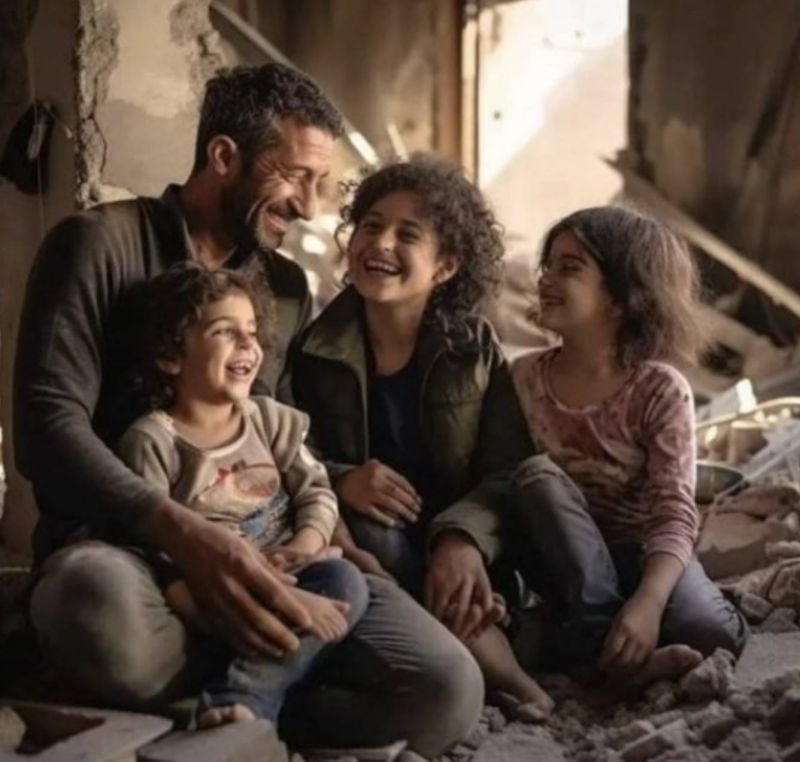
Photo generated by artificial intelligence circulating on social networks.
The image(above) shows a father with his son and two daughters at this side. They smile and hug each other. It appears to be a classic family portrait. Except for one thing: the backdrop is the rubble of Gaza, which has suffered under the bombardment of the Israeli Army since the Hamas attack on Oct. 7.
The image has been circulating for over a week on social media and WhatsApp groups, with the usual “forwarded many times” notice, making it virtually impossible to trace the source.
The message is accompanied by the following text: “Look at the impossible high spirit in their magical smiles, defying Israeli genocide against them. Such a people will never leave, will never be defeated, and will never disappear. This is the photo of the century.”
However, this “photo of the century” is generated by artificial intelligence. Despite the abundance of real and recent images coming out of Gaza depicting dust, blood, tears and dismembered bodies — void of smiles — the proliferation of AI-generated images of the conflict on social networks is noteworthy.
While the phenomenon of AI-generated images is not novel, what appears to be new is that some of these artificial photos, crafted and disseminated by regular internet users, convey a sanitized version of the tragedy — one without tears or blood.
Indeed, the scenes are staged in ruins and some faces are covered in soot and dust, but, in these photos, faces bear smiles, as if aiming to impart a sense of hope.
How can we make sense of this inclination toward a polished aesthetic, reminiscent in some respects of marketing codes, within the context of such an atrocious reality?
Serving hope and alter-reality
“I thought it was photographically beautiful,” said Carla, one of many social media users who fell for the deceptive photos. “We move very quickly through the news feeds on our social networks that we don’t take the time to look at them properly,” she continued.
While “reworked” images and their use in “disinformation” campaigns in wartime contexts are nothing new, the technique has now reached heights that digital education can’t keep up with.
“AI-generated images have evolved considerably in just a few years,” explained Ayse Lokmanoglu, Professor of Communication at Clemson University. “In the past, they were easy to spot as fakes, featuring characteristics such as extra fingers or unusual proportions.”
“It doesn’t matter that it’s generated by artificial intelligence, what’s important is its symbolism; despite the bombings, despite everything these children are being put through, they refuse to be defeated,” said Ziad, in reference to an AI-generated photo he shared on his Instagram feed on Oct. 21.
The photo depicts three children with almost painted features, covered in dust but smiling, one of them “proudly” displaying a Palestinian flag. All against a backdrop of ruins.
While some of Ziad’s followers failed to spot the artificial nature of the photo, Ziad says he chose to share it with full knowledge of the facts.
On the photo’s feed, a commenter wrote: “Such an incredible photo! It carries so much meaning. I hope their parents made it out safely.”
“These images remind me of the way the Islamic State used to present its soldiers, all smiles, trying to convey a sense of resilience and hope,” Ayse Lokmanoglu said.
“Today, people want to spread that warmth and positivity they want to see emanating from Gaza, even if it doesn’t reflect the actual event,” she continued. “It’s a bit like sharing a photo of a flower growing through concrete.”
The importance of digital education
Artificial intelligence creates these types of pictures based on similar pre-existing images.
“These [pre-existing] images are often collected from the internet, including social networks, advertisements and even excerpts from cultural productions available online,” said Assia Wirth, a PhD student at Université Paris-Saclay working on AI applied to image processing. “The images generated reflect the visual codes present in this training material, which are often staged and retouched.”
“So, we find the smile, the framing, the composition, etc., whose codes are now well defined,” she added.
When employed to portray an alternative version of reality, these images seem more focused on communication than on sharing information. However, the blending of genres in a highly charged news sequence like the Hamas-Israel war carries inherent dangers.
“These images take us away from real conflicts, which makes it difficult to react appropriately,” Lokmanoglu said. “When we react to such images, we’re responding to someone else’s agenda, not to the truth of the situation.”
If today the technical means of verification are not always directly available, it is “essential that everyone becomes aware of the importance of digital education to understand the consequences of sharing AI-generated images online,” said Assia Wirth.
“It’s necessary to develop critical reading skills to spot signs of manipulation in these images,” she added. “Nowadays, we’re still a long way from having a proper critical view of images shared on social networks.”
This article was originally published in French in L'Orient-Le Jour. Translation by Sahar Ghoussoub.
